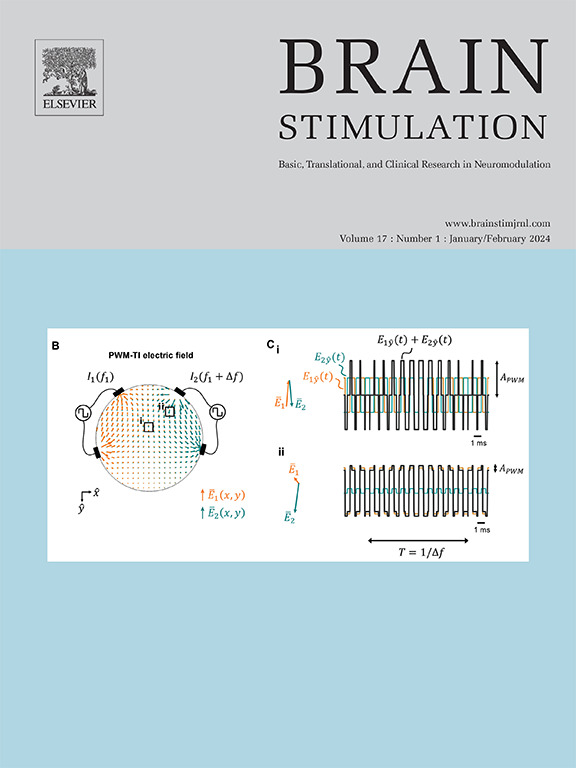Electrical stimulation of the dorsolateral prefrontal cortex inhibits vestibular signalling in humans: A BOLD fMRI study
IF 7.6
1区 医学
Q1 CLINICAL NEUROLOGY
引用次数: 0
Abstract
Background
Low-frequency sinusoidal galvanic vestibular stimulation (sGVS) can induce perceptions of sway and nausea through entraining vestibular afferent firing to the sinusoidal stimulus. As recently shown, concurrent dorsolateral prefrontal cortex (dlPFC) stimulation via transcranial alternating current stimulation (tACS) greatly attenuates these vestibular perceptions.
Objective
Given that both vestibular afferents and dlPFC efferents project to the insular cortex, it was reasoned that the insula is the most likely area for the top-down inhibitory interaction to take place.
Methods
To identify the sites of this interaction, blood-oxygen-level-dependent (BOLD) functional magnetic resonance imaging (fMRI) was collected whilst simultaneously delivering sinusoidal electrical stimulation (±2 mA, 0.2 Hz, 60 cycles) to 20 participants. These stimuli were randomly applied as follows: (i) bilateral sGVS alone via the mastoid processes; (ii) tACS of the dlPFC alone at electroencephalogram site F4; and (iii) sGVS and tACS together.
Results
Altered BOLD signal-intensity patterns were identified in the parieto-insular vestibular cortex and thalamus when comparing both sGVS and dlPFC stimulation to concurrent stimulation. Within the brainstem, signal-intensity increased in the inferior olivary nucleus and decreased in the nucleus of the solitary tract during concurrent stimulation, when analysed relative to single stimuli. Because concurrent stimulation elicited different activation patterns in each of these regions compared to the single stimuli, they were considered to be key for the interaction.
Conclusion
Given the role each plays in dlPFC and vestibular pathways, the inhibitory function exerted by the dlPFC on vestibular processing likely involves ongoing modulation of one or several of these cortical or subcortical areas.
电刺激背外侧前额叶皮层抑制人类前庭信号:一项大胆的fmri研究。
背景:低频正弦波前庭电刺激(sGVS)可以通过诱导前庭传入放电产生正弦波刺激来诱导摇摆和恶心的感觉。正如最近所显示的那样,通过经颅交流电刺激(tACS)同时刺激背外侧前额叶皮层(dlPFC)大大减弱了这些前庭感知。目的:鉴于前庭传入和dlPFC传入都投射到岛叶皮层,因此岛叶是自上而下的抑制相互作用最有可能发生的区域。方法:为了确定这种相互作用的部位,收集了血氧水平依赖(BOLD)功能磁共振成像(fMRI),同时向20名参与者提供正弦电刺激(±2 mA, 0.2 Hz, 60个周期)。这些刺激随机应用如下:(i)双侧sGVS单独通过乳突;(ii)脑电图F4位点dlPFC单独的tACS;(iii) sGVS和tACS一起。结果:当将sGVS和dlPFC刺激与并发刺激进行比较时,在顶岛前庭皮层和丘脑中发现了改变的BOLD信号强度模式。与单一刺激相比,在脑干内,并发刺激时,下橄榄核的信号强度增加,孤立束核的信号强度降低。因为与单一刺激相比,并发刺激在这些区域中引发了不同的激活模式,因此它们被认为是相互作用的关键。结论:考虑到各自在dlPFC和前庭通路中的作用,dlPFC对前庭加工的抑制功能可能涉及对其中一个或几个皮质中心的持续调节。
本文章由计算机程序翻译,如有差异,请以英文原文为准。
求助全文
约1分钟内获得全文
求助全文
来源期刊

Brain Stimulation
医学-临床神经学
CiteScore
13.10
自引率
9.10%
发文量
256
审稿时长
72 days
期刊介绍:
Brain Stimulation publishes on the entire field of brain stimulation, including noninvasive and invasive techniques and technologies that alter brain function through the use of electrical, magnetic, radiowave, or focally targeted pharmacologic stimulation.
Brain Stimulation aims to be the premier journal for publication of original research in the field of neuromodulation. The journal includes: a) Original articles; b) Short Communications; c) Invited and original reviews; d) Technology and methodological perspectives (reviews of new devices, description of new methods, etc.); and e) Letters to the Editor. Special issues of the journal will be considered based on scientific merit.
 求助内容:
求助内容: 应助结果提醒方式:
应助结果提醒方式:


